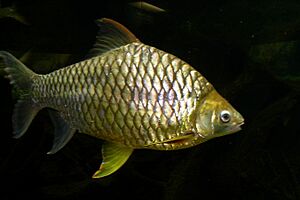Golden belly barb facts for kids
Quick facts for kids Golden belly barb |
|
|---|---|
 |
|
| Conservation status | |
| Scientific classification | |
| Synonyms | |
|
The golden belly barb (Hypsibarbus wetmorei) is a type of cyprinid fish. This family of fish includes carps and minnows. It is also known by other names like lemon fin barb or lemon barb. In some places, it's called Kerai or Krai.
This fish lives in several large rivers in Mainland Southeast Asia. You can find it in the Mae Klong, Mekong, Chao Phraya, Tapi, and Pahang rivers. Even though it's common in its home areas, it faces some dangers. These include too much fishing, dams that block its path, and pollution in the water.
About the Golden Belly Barb
The golden belly barb is a medium-sized fish. It usually grows to about 25 centimeters (10 inches) long. However, some have been found to be much bigger, up to 70 centimeters (27.5 inches)!
Why is this Fish Important?
People often catch the golden belly barb for food. It's a popular fish to eat in the areas where it lives. It's also kept as an ornamental fish in aquariums. Sometimes, you might see special shapes of this fish in aquariums. These are called "balloon" or "Pla san" fish. "Pla san" means "shortened fish" or "dwarf fish" in Thai.
In Thailand, this fish has many local names. Some of these names are Pla Tapak, Pla Tapak Lueng, Pla Tapak Thong, or Pla Krapak. These names even appear in old poems, like one by King Rama V called "Journey to Sai Yok".
Conservation Efforts
Scientists and conservationists are working to protect the golden belly barb. Since 2010, the Kamphaengpet Inland Fisheries Research and Development Center has been helping. They use a method called artificial insemination to help the fish reproduce. After the fish are born, they are released back into their natural rivers. This helps to increase the number of golden belly barbs in the wild.


